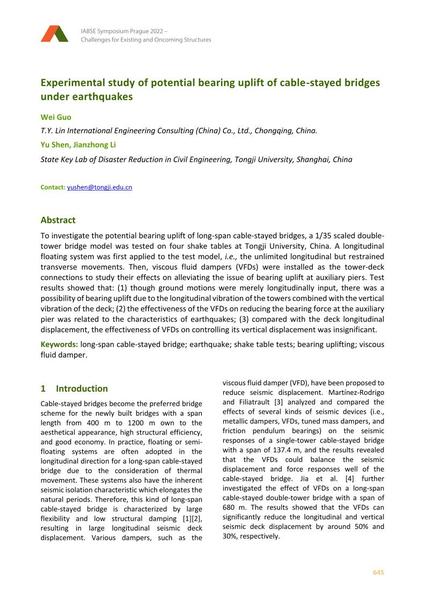Experimental study of potential bearing uplift of cable-stayed bridges under earthquakes

|
|
|||||||||||
Bibliografische Angaben
| Autor(en): |
Wei Guo
(T.Y. Lin International Engineering Consulting (China) Co., Ltd., Chongqing, China.)
Yu Shen (State Key Lab of Disaster Reduction in Civil Engineering, Tongji University, Shanghai, China) Jianzhong Li (State Key Lab of Disaster Reduction in Civil Engineering, Tongji University, Shanghai, China) |
||||
|---|---|---|---|---|---|
| Medium: | Tagungsbeitrag | ||||
| Sprache(n): | Englisch | ||||
| Tagung: | IABSE Symposium: Challenges for Existing and Oncoming Structures, Prague, Czech Republic, 25-27 May 2022 | ||||
| Veröffentlicht in: | IABSE Symposium Prague 2022 | ||||
|
|||||
| Seite(n): | 645-653 | ||||
| Anzahl der Seiten (im PDF): | 9 | ||||
| DOI: | 10.2749/prague.2022.0645 | ||||
| Abstrakt: |
To investigate the potential bearing uplift of long-span cable-stayed bridges, a 1/35 scaled double- tower bridge model was tested on four shake tables at Tongji University, China. A longitudinal floating system was first applied to the test model, i.e., the unlimited longitudinal but restrained transverse movements. Then, viscous fluid dampers (VFDs) were installed as the tower-deck connections to study their effects on alleviating the issue of bearing uplift at auxiliary piers. Test results showed that: (1) though ground motions were merely longitudinally input, there was a possibility of bearing uplift due to the longitudinal vibration of the towers combined with the vertical vibration of the deck; (2) the effectiveness of the VFDs on reducing the bearing force at the auxiliary pier was related to the characteristics of earthquakes; (3) compared with the deck longitudinal displacement, the effectiveness of VFDs on controlling its vertical displacement was insignificant. |
||||
| Stichwörter: |
Erdbeben
|
||||
| Copyright: | © 2022 International Association for Bridge and Structural Engineering (IABSE) | ||||
| Lizenz: | Die Urheberrechte (Copyright) für dieses Werk sind rechtlich geschützt. Es darf nicht ohne die Zustimmung des Autors/der Autorin oder Rechteinhabers/-in weiter benutzt werden. |
||||

